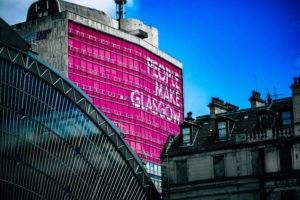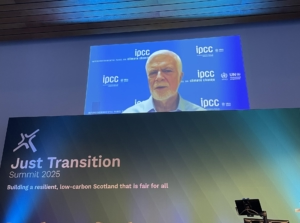Blog
Just Resilience – crucial to a Just Transition

Verture CEO Jo Kerr explores why adaptation, and resilience needs to be embedded in just transition ambitions.
There are communities across Scotland, where low incomes and poor health outcomes are felt at the same time as poor air quality, flood risk and urban heat island effect. In July, The Gorbals in Glasgow recorded the highest temperature in the country – a degree hotter than the rest of the city – due to the design of the buildings and a lack of green space. This is a climate issue, but it is also a social justice and equity issue.
Community organisation Crossroads, in partnership with others in The Gorbals, have carried out fantastic artist-led and co-produced work through Creative Climate Futures to start their adaptation journey. They planted an orchard of trees and mapped walking routes with bee posts. This is just resilience – the opportunity to tackle social and environmental challenges together.
We’ve talked before about transformational adaptation before (as popularised by the MACC Hub, as well as Rupert Read of the Climate Majority Project). Just resilience is a similar concept, with important alignment to the key policy area of just transition.

What is just transition?
Just transition is a term with a history. The term was coined in the 1970s in North America, when labour unions advocated for protections for workers going through industrial shifts. Since then, its meaning has expanded. By the 2000s it included climate change and became popular through its inclusion in the 2015 Paris Agreement. Today, the concept covers social and environmental justice beyond the workforce, including within communities.
The Scottish Government is committed to a just transition, with independent scrutiny and advice coming from the Just Transition Commission.
Government’s commitment to just transition has, until now, had a net zero focus: “We are determined to achieving net zero in a way that distributes the costs and benefits fairly, and which tackles inequality and injustice.”
We must transition to net zero in an equitable way, and we must support people working in extractive industries like oil and gas in North East Scotland, to retrain into well-paid roles. The past focus isn’t wrong, it just needs to be broadened.
Where does just resilience fit in?
At a basic level, we know we need to embed adaptation in the shift to net zero, or risk damage to our clean energy infrastructure by climate impacts. But just resilience is much more than protecting what we have. This is an opportunity to make peoples’ lives better.
As we’ve explored on this blog before, we know the people most impacted by climate change are not the ones who created the problem. Climate change impacts like flooding, over-heating and storm damage are, and will be, felt the most by communities who are already marginalised by society: people on low incomes, disabled people, black and brown people, older people.
On 29 October, the Just Transition Commission hosted the Just Transition Summit, via video IPCC Chair Jim Skea called for adaptation and resilience to be part of Just Transition plans, because the impacts of climate change are here now.

What could the future look like?
Communities across Scotland must be heard and protected in a changing climate. And just resilience presents opportunities to make places better. We can solve social problems at the same time as climate ones.
Solutions should include:
- More and better green space
- Better public transport
- Community growing and food networks
- Improved housing and retrofit
- Healthcare resilience
These developments would ensure people and places have what they need to adapt, participate and thrive. At Verture, we’re focused on creating the spaces and relationships that help make this possible. Expect more on this within our 2026-31 strategy.
And remember: a Just Transition can only succeed when we include just resilience.
